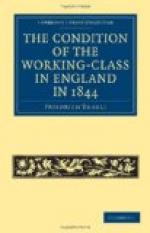It is by no means unusual for the manufacturer of Parr’s Life Pills to sell twenty to twenty-five thousand boxes of these salutary pills in a week, and they are taken for constipation by this one, for diarrhoea by that one, for fever, weakness, and all possible ailments. As our German peasants are cupped or bled at certain seasons, so do the English working-people now consume patent medicines to their own injury and the great profit of the manufacturer. One of the most injurious of these patent medicines is a drink prepared with opiates, chiefly laudanum, under the name Godfrey’s Cordial. Women who work at home, and have their own and other people’s children to take care of, give them this drink to keep them quiet, and, as many believe, to strengthen them. They often begin to give this medicine to newly-born children, and continue, without knowing the effects of this “heartsease,” until the children die. The less susceptible the child’s system to the action of the opium, the greater the quantities administered. When the cordial ceases to act, laudanum alone is given, often to the extent of fifteen to twenty drops at a dose. The Coroner of Nottingham testified before a Parliamentary Commission {105a} that one apothecary had, according to his own statement, used thirteen hundredweight of laudanum in one year in the preparation of Godfrey’s Cordial. The effects upon the children so treated may be readily imagined. They are pale, feeble, wilted, and usually die before completing the second year. The use of this cordial is very extensive in all great towns and industrial districts in the kingdom.
The result of all these influences is a general enfeeblement of the frame in the working-class. There are few vigorous, well-built, healthy persons among the workers, i.e., among the factory operatives, who are employed in confined rooms, and we are here discussing these only. They are almost all weakly, of angular but not powerful build, lean, pale, and of relaxed fibre, with the exception of the muscles especially exercised in their work. Nearly all suffer from indigestion, and consequently from a more or less hypochondriac, melancholy, irritable, nervous condition. Their enfeebled constitutions are unable to resist disease, and are therefore seized by it on every occasion. Hence they age prematurely, and die early. On this point the mortality statistics supply unquestionable testimony.
According to the Report of Registrar-General Graham, the annual death-rate of all England and Wales is something less than 2.25 per cent. That is to say, out of forty-five persons, one dies every year. {105b} This was the average for the year 1839-40. In 1840-41 the mortality diminished somewhat, and the death-rate was but one in forty-six. But in the great cities the proportion is wholly different. I have before me official tables of mortality (Manchester Guardian, July 31st, 1844), according to which




